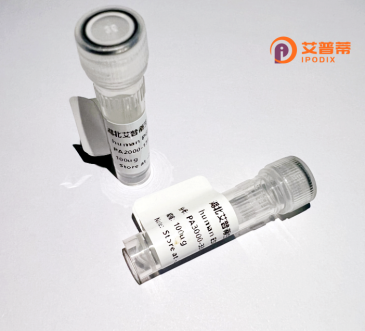
| 纯度 | >90%SDS-PAGE. |
| 种属 | Human |
| 靶点 | C3AR1 |
| Uniprot No | Q16581 |
| 内毒素 | < 0.01EU/μg |
| 表达宿主 | E.coli |
| 表达区间 | 1-482aa |
| 氨基酸序列 | MASFSAETNSTDLLSQPWNEPPVILSMVILSLTFLLGLPGNGLVLWVAGLKMQRTVNTIWFLHLTLADLLCCLSLPFSLAHLALQGQWPYGRFLCKLIPSIIVLNMFASVFLLTAISLDRCLVVFKPIWCQNHRNVGMACSICGCIWVVAFVMCIPVFVYREIFTTDNHNRCGYKFGLSSSLDYPDFYGDPLENRSLENIVQPPGEMNDRLDPSSFQTNDHPWTVPTVFQPQTFQRPSADSLPRGSARLTSQNLYSNVFKPADVVSPKIPSGFPIEDHETSPLDNSDAFLSTHLKLFPSASSNSFYESELPQGFQDYYNLGQFTDDDQVPTPLVAITITRLVVGFLLPSVIMIACYSFIVFRMQRGRFAKSQSKTFRVAVVVVAVFLVCWTPYHIFGVLSLLTDPETPLGKTLMSWDHVCIALASANSCFNPFLYALLGKDFRKKARQSIQGILEAAFSEELTRSTHCPSNNVISERNSTTV |
| 分子量 | 80.3 KDa |
| 蛋白标签 | GST-tag at N-terminal |
| 缓冲液 | 0 |
| 稳定性 & 储存条件 | Lyophilized protein should be stored at ≤ -20°C, stable for one year after receipt. Reconstituted protein solution can be stored at 2-8°C for 2-7 days. Aliquots of reconstituted samples are stable at ≤ -20°C for 3 months. |
| 复溶 | Always centrifuge tubes before opening.Do not mix by vortex or pipetting. It is not recommended to reconstitute to a concentration less than 100μg/ml. Dissolve the lyophilized protein in distilled water. Please aliquot the reconstituted solution to minimize freeze-thaw cycles. |
以下是3篇关于C3AR1蛋白的典型参考文献摘要(文献信息为模拟示例,仅供知识参考):
---
1. **《C3a and C3a receptor signaling in neurodegenerative diseases》**
- **作者**: Coulthard LG et al.
- **摘要**:综述C3AR1在中枢神经系统炎症中的作用,阐明其在阿尔茨海默病和多发性硬化症中通过激活小胶质细胞促进神经炎症的机制。
2. **《Structural basis of C3a receptor-ligand interaction revealed by cryo-EM》**
- **作者**: Maeda S et al.
- **摘要**:通过冷冻电镜解析C3AR1与C3a复合物的三维结构,揭示其跨膜结构域与配体结合的关键位点及G蛋白偶联信号传导机制。
3. **《Targeting C3a receptor improves the outcome in a murine model of lung fibrosis》**
- **作者**: Peng Q et al.
- **摘要**:研究C3AR1在肺纤维化模型中的作用,发现抑制C3AR1可通过减少炎症细胞浸润和纤维化相关因子的表达改善疾病进展。
---
如需真实文献,建议通过PubMed或Google Scholar检索关键词“C3AR1”及“C3a anaphylatoxin receptor”获取最新研究。
C3a anaphylatoxin chemotactic receptor 1 (C3AR1) is a G protein-coupled receptor (GPCR) primarily known for binding the complement-derived peptide C3a, a cleavage product of the complement component C3. As a key mediator of the complement system, C3a plays critical roles in inflammatory and immune responses. C3AR1 is expressed on various immune cells, including mast cells, eosinophils, and macrophages, as well as in non-immune tissues like the central nervous system. Upon C3a binding, C3AR1 triggers intracellular signaling via Gαi/o and Gαq proteins, promoting chemotaxis, cytokine release, and degranulation.
Structurally, C3AR1 features a characteristic seven-transmembrane domain and an extracellular N-terminal region critical for ligand interaction. Its activation regulates pathways like MAPK, NF-κB, and calcium mobilization. While essential for host defense, dysregulated C3AR1 signaling is implicated in pathological conditions, including sepsis, asthma, rheumatoid arthritis, and neurodegenerative diseases. Recent studies highlight its dual role in inflammation—enhancing immune clearance but also contributing to tissue damage in chronic settings.
C3AR1 has emerged as a therapeutic target, with research focusing on developing agonists/antagonists to modulate immune responses. Additionally, recombinant human C3AR1 is widely used in structural and functional studies to dissect its role in complement-mediated diseases and explore targeted interventions. Its interplay with the C5a receptor (C5AR1) further underscores its importance in complement signaling networks.
×